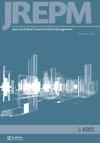Defining 24-Hour and 18-Hour Cities, Assessing Their Vibrancy, and Evaluating Their Property Performance
Q2 Economics, Econometrics and Finance
Journal of Real Estate Portfolio Management
Pub Date : 2017-01-01
DOI:10.1080/10835547.2017.12090000
引用次数: 1
Abstract
Executive Summary. Indicators originally used to define 24-hour cities are updated to redefine 24-hour cities in the United States. From the sample of 42 large cities, we identify six 24-hour cities and nine 18-hour cities. The six 24-hour cities (Tier I), nine 18-hour cities (Tier II), and 27 9-to-5 cities (Tier III) are compared. For office properties, investment performance indicators correspond in rank order to Tiers I–III. For apartments, however, the results are less consistent. Dislocations in housing markets over the past decade have prompted a notable investor preference for multifamily investment in Tier II and Tier III markets during the recovery from the Global Financial Crisis.定义24小时和18小时城市,评估其活力,评估其房地产绩效
执行概要。在美国,最初用于定义24小时城市的指标被更新为重新定义24小时城市。从42个大城市的样本中,我们确定了6个24小时城市和9个18小时城市。6个24小时城市(一线)、9个18小时城市(二线)和27个朝九晚五城市(三线)进行了比较。对于办公物业,投资绩效指标按等级顺序对应于一级至三级。然而,对于公寓来说,结果就不那么一致了。在全球金融危机复苏期间,过去十年房地产市场的混乱促使投资者明显倾向于在二线和三线市场投资多户住宅。
本文章由计算机程序翻译,如有差异,请以英文原文为准。
求助全文
约1分钟内获得全文
求助全文
来源期刊

Journal of Real Estate Portfolio Management
Economics, Econometrics and Finance-Economics, Econometrics and Finance (miscellaneous)
自引率
0.00%
发文量
13
期刊介绍:
The Journal of Real Estate Portfolio Management (JREPM) is a publication of the American Real Estate Society (ARES). Its purpose is to disseminate applied research on real estate investment and portfolio management.
 求助内容:
求助内容: 应助结果提醒方式:
应助结果提醒方式:


